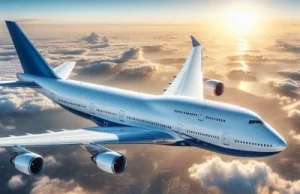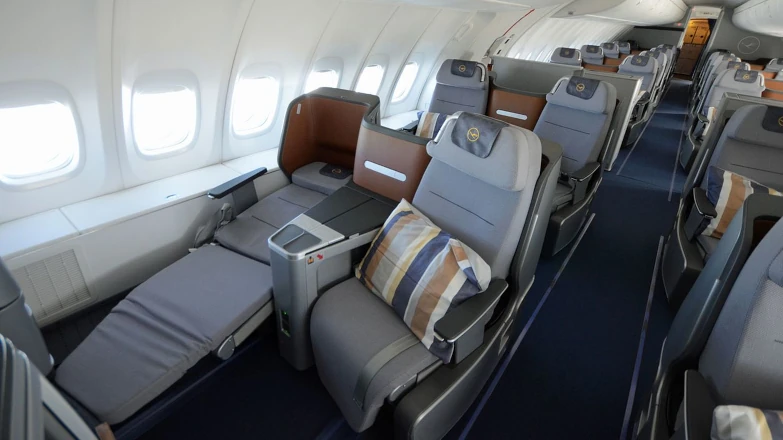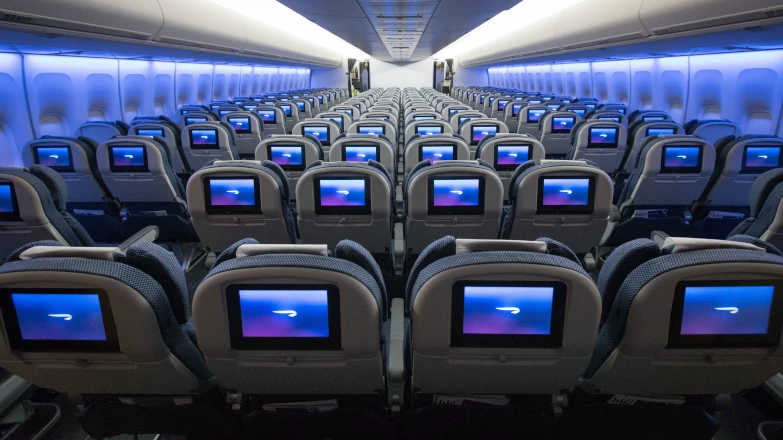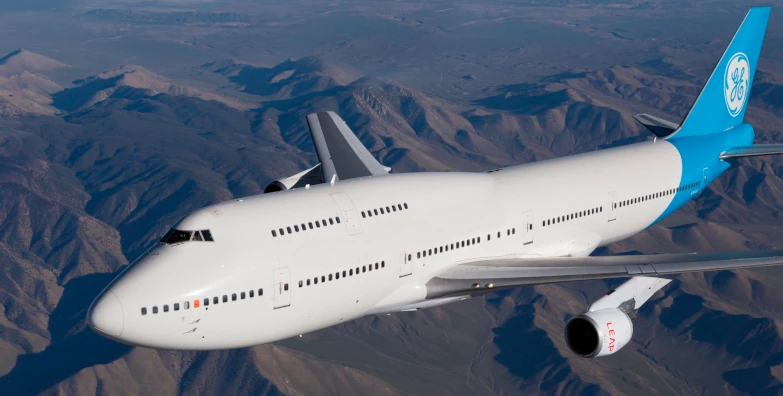
747 Plane Family Overview
Introducing the 747 Plane
The Boeing 747, affectionately known as the “Jumbo Jet,” stands tall as a revolutionary icon in aviation history. Crafted by the esteemed American aerospace manufacturer Boeing, this majestic four-engine aircraft first took to the skies on February 9, 1969, heralding a new era in long-range air travel.
From its maiden flight, the B747 captured the imagination of travelers worldwide, boasting unprecedented size, weight, and spaciousness. For an impressive span of 36 years, it proudly held the title of the largest and heaviest passenger aircraft until the advent of the Airbus A380. Notably, a historic moment etched in aviation lore occurred during Operation Solomon on May 24, 1991, when an El Al-operated 747 Boeing orchestrated the remarkable feat of ferrying 1,122 passengers on a singular voyage to Israel, a testament to its unparalleled capacity.
One of the defining features of the B747 is its distinctive double-deck configuration, with the iconic “hump” atop the fuselage, granting it an unmistakable silhouette. This architectural marvel not only set new standards for aerial engineering but also ensured the 747’s status as an instantly recognizable presence in skies across the globe. The 747 is available in various models, most of which are equipped for long-haul flights. Notably, in 1989, a 747 operated by Australia’s Qantas Airways completed a non-stop flight from London to Sydney, covering 18,000 kilometers in 20 hours and 9 minutes, without any passengers or cargo on board.
Despite its significant operational expenses, the 747 Plane continues to be one of the most common wide-body passenger jets due to the economies of mass air travel and various leasing options. As of November 2020, Boeing had received orders for 1,571 different configurations of the 747, with 1,559 of these aircraft already delivered to clients.
Development History of the B747
The concept for the B-747 was born out of the rapid growth in air travel during the 1960s. At that time, the Boeing 707 was the predominant aircraft in the US airline market but was becoming insufficient to manage the increasing number of passengers. In parallel, Boeing was developing a large military transport aircraft for the U.S. Air Force but lost to Lockheed’s C-5 Galaxy. Nevertheless, Pan American Airlines, a dedicated supporter of Boeing, championed the development of a much larger passenger aircraft, eventually leading to the creation of a plane twice the size of the 707. The 747 model was unveiled in 1966, with Pan Am ordering 25 of the initial 100 units.
Originally expected to be overshadowed by supersonic jets, the 747 Plane was thoughtfully designed for versatility, especially for easy conversion between passenger and cargo configurations. Its cockpit was strategically placed on the upper deck, which allowed the nose of the aircraft to be converted into a cargo ramp, a feature made possible by the extended “hump” of the upper deck.
To improve the aircraft’s safety and performance, Pratt Whitney developed the robust JT9D twin turbofan engine, initially used exclusively for the 747. The aircraft also featured four redundant hydraulic systems and adjustable wing slats to accommodate operations on standard-length runways.
For certification, Boeing introduced the “Waddell Van,” an innovative training tool named after test pilot Jack Waddell. This simulator, which consisted of a mock cockpit mounted on the roof of a truck, was designed to train pilots in handling the aircraft from its elevated cockpit position.
During its development, the smaller Boeing 737 also experienced significant changes, evolving from a 60-seat airliner to one capable of seating up to 103 passengers, while still maintaining its initial design goals.
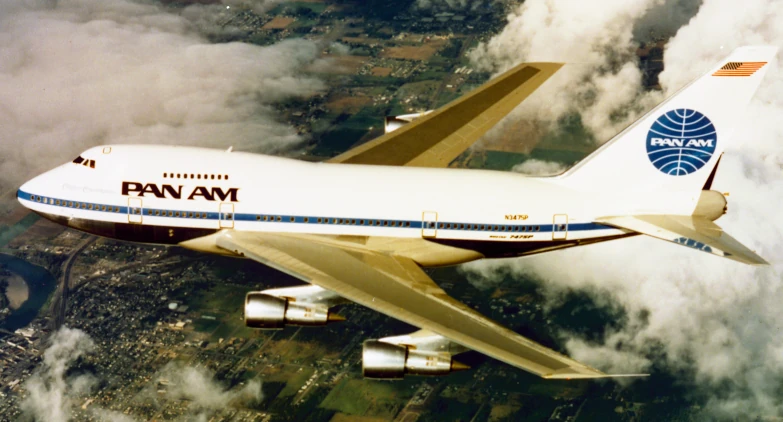
Boeing 747 Architectural Overview
Fuselage: The 747 Boeing is celebrated for its iconic double-decker cabin design, which maximizes space for both passengers and cargo, ensuring a comfortable and convenient journey. This structure incorporates cutting-edge technologies that bolster the aircraft’s safety and operational efficiency.
Wings: Essential to its design, the wings of the B747 provide crucial lift for takeoff and sustained flight. Characterized by their sweeping cut ends and expansive span, they enhance the plane’s aerodynamic performance, contributing to greater fuel efficiency and stability during flight.
Cockpit: Positioned at the forefront of the 747 Plane, the cockpit houses sophisticated aeronautical systems and instrumentation. This advanced setup, combined with ergonomic design elements, allows pilots to maintain comprehensive control over the aircraft.
Engines: Equipped with four potent turbojet engines beneath its wings, the Boeing 747 boasts formidable thrust capabilities. These engines enable the aircraft to cover long distances and maintain its status as a preferred option for international air transport.
Boeing 747 Evolution
Over the years, 747 Plane has seen several modifications, each incorporating more refined technology and striving for excellence in aviation. Here’s a closer look at its evolution:
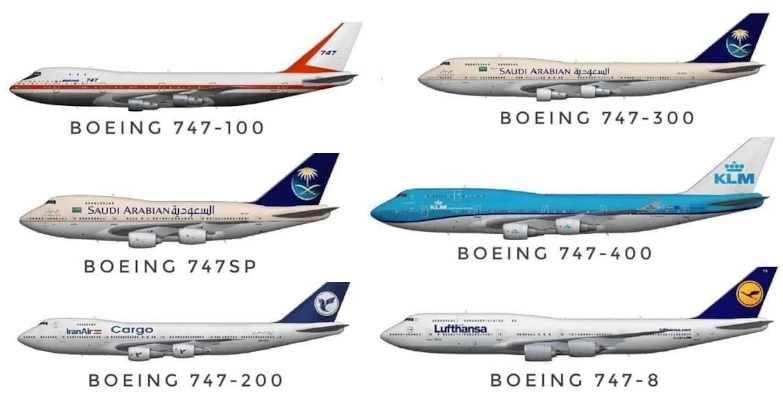
The Boeing 747 persists as a beacon of engineering excellence and innovative design in aviation, setting the standard for passenger comfort and reliability. Its grandeur and sophistication continue to inspire and awe travelers across generations.
747 Plane Technical Details
Passenger Cabin
| Model | Crew | Number of Passengers |
|---|---|---|
| Boeing 747-100 | 2 pilots and 1 flight engineer | 366 (standard configuration), 440 (maximum) |
| Boeing 747-200 | 2 pilots and 1 flight engineer | 366 (standard configuration), 550 (maximum) |
| Boeing 747-300 | 2 pilots and 1 flight engineer | 400 (standard configuration), 550 (maximum) |
| Boeing 747-400 | 2 pilots | 416 (standard configuration), 660 (maximum) |
| Boeing 747-8 | 2 pilots | 467 (standard configuration), 605 (maximum) |
Dimensions
| Model | Length (m) | Height (m) | Wingspan (m) | Wing Area (m²) | Fuselage Width (m) | Cabin Width (m) |
|---|---|---|---|---|---|---|
| Boeing 747-100 | 70.66 | 19.30 | 59.60 | 511.0 | 6.50 | 6.10 |
| Boeing 747-200 | 70.66 | 19.30 | 59.60 | 511.0 | 6.50 | 6.10 |
| Boeing 747-300 | 70.66 | 19.30 | 59.60 | 511.0 | 6.50 | 6.10 |
| Boeing 747-400 | 70.66 | 19.30 | 59.60 | 511.0 | 6.50 | 6.10 |
| Boeing 747-8 | 76.25 | 19.40 | 64.40 | 554.0 | 6.50 | 6.10 |
Mass
| Model | Equipped Empty Mass (kg) | Maximum Takeoff Mass (kg) | Cargo Compartment Volume (m³) |
|---|---|---|---|
| Boeing 747-100 | 172100 | 333000 | 175 |
| Boeing 747-200 | 170100 | 378000 | 175 |
| Boeing 747-300 | 174000 | 378000 | 175 |
| Boeing 747-400 | 187010 | 412760 | 175 |
| Boeing 747-8 | 220130 | 447700 | 176 |
Flight Data
| Model | Range (km) | Cruise Speed (km/h) | Maximum Speed (km/h) | Takeoff Length (m) | Engines | Engine Thrust (kN) | Maximum Fuel (L) | Maximum Flight Altitude (m) |
|---|---|---|---|---|---|---|---|---|
| Boeing 747-100 | 8560 | 908 | 988 | 3250 | 4 × Pratt & Whitney JT9D or 4 × Rolls-Royce RB211 or 4 × General Electric CF6 | 4 × 193-230 | 183380 | 13750 |
| Boeing 747-200 | 12150 | 908 | 988 | 3300 | 4 × Pratt & Whitney JT9D or 4 × Rolls-Royce RB211 or 4 × General Electric CF6 | 4 × 206-243.5 | 204360 | 13750 |
| Boeing 747-300 | 11720 | 908 | 988 | 3300 | 4 × Pratt & Whitney JT9D or 4 × Rolls-Royce RB211 or 4 × General Electric CF6 | 4 × 206-253 | 204360 | 13750 |
| Boeing 747-400 | 14320 | 917 | 988 | 3300 | 4 × Pratt & Whitney JT9D or 4 × Rolls-Royce RB211 or 4 × General Electric CF6 | 4 × 206-253 | 204360 | 13750 |
| Boeing 747-8 | 14320 | 917 | 956 | 3100 | 4 × General Electric GEnx-2B67 | 4 × 296 | 238610 | 13100 |
Boeing 747: Service Classes
With its iconic hump and grand dimensions, the 747 family has been a beacon of prestige in the aviation industry, offering a spectrum of service classes tailored to meet diverse passenger needs and desires.
Economy Class: Accessible Comfort At the core of accessibility, Economy Class on the Boeing 747 delivers a comfortable and cost-effective means to traverse the globe. Thoughtfully designed seats optimize space, ensuring a pleasant journey on long-haul flights. Overhead bins and personal entertainment systems ensure that even the most budget-conscious travelers fly with convenience and comfort.
Premium Economy: Where Luxury Meets Affordability For those seeking an elevated experience without the extravagance of premium classes, Premium Economy Class strikes the perfect balance. Offering additional legroom, enhanced meal services, and priority boarding, passengers luxuriate in a more refined journey while remaining grounded in practicality.
Business Class: A Sanctuary for Professionals Tailored to meet the needs of the modern traveler, Business Class on the B747 serves as a sanctuary for productivity and relaxation. Featuring lie-flat seats, gourmet dining options, and exclusive lounge access, the cabin fosters a conducive environment for work or leisure, ensuring a seamless travel experience.
First Class: The Ultimate in Airborne Luxury At the pinnacle of air travel, First Class aboard the 747 Plane sets the standard for opulence and refinement. From spacious suites to exquisite dining offerings, every detail is meticulously crafted to indulge the senses. With attentive service and a serene ambiance, passengers are treated to an unparalleled journey that exceeds even the loftiest expectations.
The 747 Boeing Experience Irrespective of the chosen class, the Boeing 747 continues to inspire awe as a testament to human innovation and connectivity. As it graces the skies, each service class within this legendary aircraft family promises a journey as unforgettable as the destination itself.

